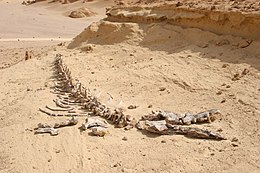Wadi al-Hitan
| Wadi al-Hitan (Valley of the Whales) | |
|---|---|
|
UNESCO world heritage |
|

|
|
| Skeleton of Dorudon atrox |
|
| National territory: |
|
| Type: | nature |
| Criteria : | viii |
| Surface: | 20,015 ha |
| Reference No .: | 1186 |
| UNESCO region : | Arabic states |
| History of enrollment | |
| Enrollment: | 2005 (session 29) |
The Wadi al-Hitan ( Arabic وادي الحيتان Wādī al-Hītān , DMG Wādī al-Ḥītān 'Valley of the Whales') is a dry valley ( wadi ) in the governorate of al-Fayyum in northern Egypt . It belongs since 2005 to UNESCO - World Heritage .
The "Valley of the Whales" is part of the Wadi el-Rayan nature reserve, which has existed since 1989. The protected area covers 1,759 km² and connects to the west of the Fayyum oasis (southwest of the capital Cairo ). Here are numerous fossil remains of Archaeoceti , an early, extinct suborder of the whales . The valley was closed to cars because too many valuable fossil finds were run over and destroyed.
geology
Around 40 million years ago, during the Eocene , the Tethys Ocean was located here for around two million years . Then tectonic forces lifted the terrain and the sea was pushed back . The remains of the sea creatures were embedded in sediments .
Today you can discover the fossilized skeletons of primitive whales, shark teeth , mussels and corals as well as other traces of past marine life in the eight square kilometer area . Petrified mangrove roots from that era can also be found. These finds allow a reconstruction of the paleoecology , i.e. the living conditions of that time.
The whale skeletons are of particular interest - a total of 250 specimens have been discovered so far. These are the remains of the genera Basilosaurus ("King Lizard") and Dorudon atrox . The first bones of Basilosaurus were found in the United States in 1830 and were mistaken for the remains of a reptile. The English anatomist Richard Owen , however, recognized that it was a mammal and suggested a renaming in Zeuglodon ("yoke"). But according to the priority principle , the older name applies, even if “Zeuglodon” remained a frequently used synonym . The Wadi al-Hitan is therefore also called "Wadi Zeuglodon".
These fossils can be used to prove the descent of the whales from land animals. The fossils still have remnants of the hind legs, but they already have the streamlined shape that has been adapted to aquatic life .
Around a dozen of the best places where whale spines were found are marked and secured by ropes to the left and right of the marked path. More bones are buried under mounds of earth or rubble, which is why one should neither climb on these piles nor drive over them.
Diplomatic affair
In August 2007, Egyptian authorities accused Belgian diplomats of damaging one of the skeletons with their SUV. Claims for damages in the six-digit range are in the room.
Web links
- Entry on the UNESCO World Heritage Center website ( English and French ).
- Koenigswald, Wighart von (2008): “A journey into the valley of the whales: Searching for traces of evolution”. Fossils 25 (3): 147–152. ( online ( memento from October 19, 2014 in the Internet Archive ), PDF, 693 KiB)
- Whales in the desert . From Tom Mueller. In Spiegel Online from October 25, 2010
Individual evidence
- ^ Egyptian Environmental Affairs Agency , accessed January 5, 2012.
- ^ Egyptian Environmental Affairs Agency , accessed January 5, 2012.
- ↑ WDR 5, Leonardo, August 30, 2007
- ^ Spiegel Online: Belgian diplomats are said to have damaged whale fossils. August 27, 2007 [1]
Coordinates: 29 ° 16 ′ 15 ″ N , 30 ° 2 ′ 38 ″ E



